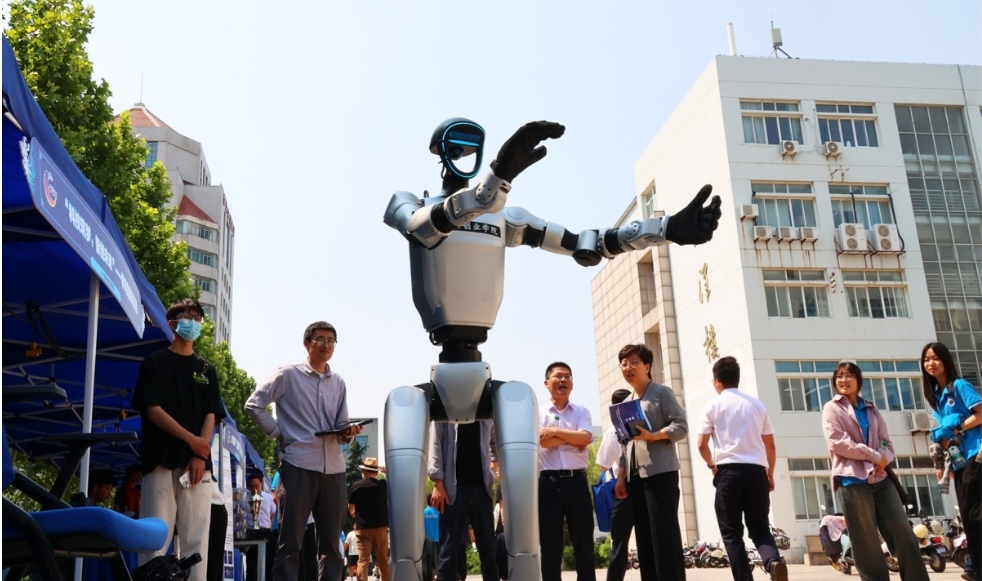Demonstrating tech progress: Robot dancing and fighting

A humanoid robot performs at a carnival held at Jiangsu Ocean University in Lianyungang, East China’s Jiangsu Province on May 28, 2025
Wang Xingxing, Unitree Robotics founder and CEO discussed the use of humanoid robots in dancing and fighting competitions, saying such performances are crucial for developing their full-body movement capabilities as the company works toward deploying them for labor-intensive tasks.
“Our ultimate goal is to have AI-powered robots take on arduous work for humans, but before that’s achievable, participating in performances allows us to showcase real technological progress and generate some commercial value,” Wang said at the Beijing Academy of Artificial Intelligence (BAAI) Conference, which was held in Beijing on Friday 6 Jun.
The comments came amid scepticism over whether flashy demonstrations of humanoid robots dancing or fighting are relevant for real-world challenges like functional adaptability and commercial applications.
The company’s robots performed at this year’s Spring Festival Gala, and their smooth movements drew enthusiastic reactions.
Wang said that the rental market for humanoid robots has been booming in the first half of this year, adding that the competitions themselves have already brought some industrial value. He also believes that robot fighting will become a popular sporting event in the next few years.
China’s humanoid robot industry, as one of the representative fields for new quality productive forces, is seeing a period of upward growth.
Since the beginning of 2025, World has witnessed remarkable acceleration in the development of humanoid robots. Companies are driving continuous technological innovation, enhancing the robots’ mobility, intelligence, and interactive capabilities, which lays a solid foundation for more widespread adoption.
Humanoid robots are also demonstrating their economic significance. The R&D, production, and sales of humanoid robots directly stimulate growth in related industries, creating new economic growth engines. Also, their applications across various sectors – such as industrial manufacturing, logistics, healthcare, and services – boost productivity, reduce costs, improve service quality, and facilitate the transformation and upgrading of traditional industries, injecting fresh impetus into economic development.
The 2025 Humanoid Robotics and Embodied Intelligence Industry Research Report shows that in 2025, China’s embodied intelligence market is expected to reach INR6350Crores (5.30 billion yuan), accounting for approximately 27 percent of the global market; and the humanoid robotics market is projected to reach INR 9950 Crores (8.239 billion yuan) representing about 50 percent of the global total, according to China News Service.
The rapid development of the embodied intelligence sector has generated investment momentum. Data Information Technology Companies shows that as of May 30, there have been over 300 global robot-related investment events in 2025, with a total financing scale exceeding INR 24000 Crores. Investment activity in China’s robotics industry accounts for over 82 percent of the global total.
According to data from Tianyancha, as of Thursday, there are more than 900,000 robotics-related enterprises in China. Among them, 100,000 were established in the first five months of this year, a 44 percent increase compared to the same period in 2024.
India too is making significant strides in robotics, particularly in manufacturing, with a notable 59% increase in robot installations in 2023. The automotive industry is a major driver, experiencing a 139% rise in robot deployments, reflecting the increasing adoption of automation in manufacturing. With a rapidly growing market for robotics, India’s ranking is 7th globally in annual robot installations, with a record 8,510 units installed in 2023.
The Indian government is actively promoting robotics development and adoption through initiatives like “Make in India,” “Digital India,” and “Startup India”. There’s a growing trend of integrating artificial intelligence (AI) and machine learning (ML) with robotics, enhancing the capabilities and versatility of robots in various sectors. Robotics is being applied in diverse fields like healthcare, agriculture, logistics, and service robots, demonstrating its versatility and impact. India’s robotics ecosystem is poised for continued growth, with the potential to become a global leader in robotics and automation.
While there are significant advancements, challenges such as ethical considerations and societal impact need to be addressed to ensure inclusive and sustainable implementation.




